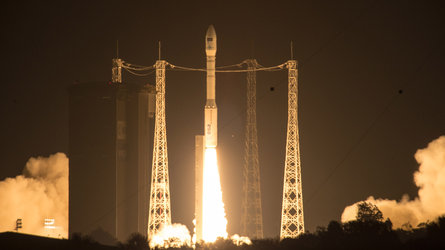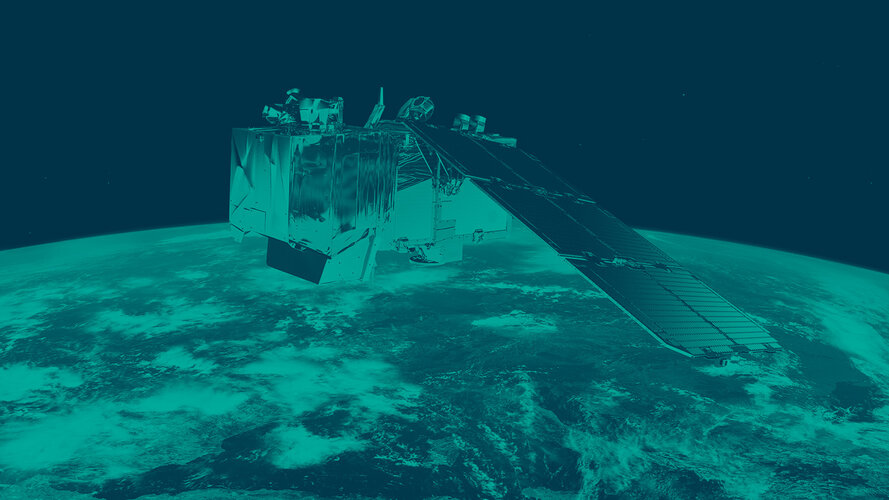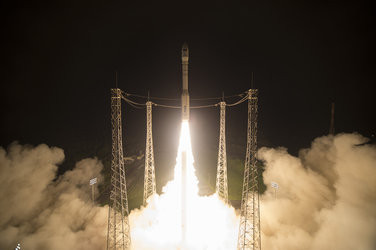Sentinel-2A completes critical first days in space
Last night marked the end of Sentinel-2A's first three days in space, which saw teams on the ground working around the clock to ensure the spacecraft is ready for its 'colour vision' mission.
The ESA-developed Sentinel-2A satellite lifted off on a Vega rocket from Europe’s Spaceport in Kourou, French Guiana at 01:52 GMT on 23 June (03:52 CEST; 22:52 local time, 22 June).
The 1.1 tonne satellite carries a high-resolution optical payload that will gather some of the best global imagery ever delivered from space of our land and vegetation for Europe’s Copernicus environmental monitoring programme.
This information will mainly be used for agricultural and forestry practices, as well as help manage food security, monitor pollution in lakes and coastal waters and contribute to more rapid disaster mapping.
Confirming end of LEOP

Delivery into orbit marked the start of the critical Launch and Early Orbit Phase (LEOP), which has seen ground teams at ESOC, ESA's space operations centre in Darmstadt, Germany, working around the clock to activate crucial onboard systems and ensure the spacecraft’s health in the extreme environment of space.
The mission control team dealt with several typical problems seen in any launch; these have been resolved and the satellite is now in excellent health.
"We conducted our first orbital manoeuvre using the Sentinel-2A thrusters yesterday, and this went exactly as planned," said Spacecraft Operations Manager Franco Marchese.
"Overall, this LEOP has gone very smoothly and we are well en route to achieving our reference orbit within next week."
Flight Director Pier Paolo Emanuelli reported yesterday that the Sentinel-2A LEOP phase had formally ended, with the spacecraft and ground systems all operating as expected.

"I wish to thank all the teams involved in Sentinel-2A – including those from industry, the project at ESTEC, ESA's technical centre, and here at ESOC – for a job well done," said Emanuelli.
"The satellite is in great shape and the commissioning phase – when we ensure the spacecraft and its multispectral imager payload are ready for routine operations – has now started."
ESA's Omar Sy, ESA’s Sentinel-2 System, Engineering and Operations Manager, responsible for the three-month satellite commissioning campaign, explained that the two main objectives now will be to assess and characterise the spacecraft performance. In parallel, calibration and validation activities will be conducted for the multispectral imager (MSI) payload involving CNES and ESA.
The spacecraft will also be readied to start the routine acquisition of high-resolution images of Earth’s land surfaces, large islands, inland and coastal waters on a ten-day revisit cycle, which will drop to five days when the constellation with the Sentinel-2B satellite is implemented in 2016.
Opening the door to a game-changing mission

"The next three months will see a lot of hard work by teams at ESOC, ESTEC, ESRIN and CNES supporting image quality activities, as well as at DLR and Tesat, as we also commission the new optical data communication capability," said Omar Sy.
"We're opening a door to a new era in space – we're confident Sentinel-2's high-resolution capability will establish new leadership, particularly for vegetation imaging."
Sentinel-2A and -2B are planned to conduct a seven-year mission, that could be extended by five years, and monitor Earth from an altitude of about 790 km.
"Following a perfect launch by Vega, the Sentinel-2A LEOP was swiftly completed by our flight control and project support teams working at ESOC," stressed Francois Spoto, ESA's Sentinel-2 Project Manager.
He noted that the spacecraft itself works very well and the 13-channel MSI instrument is getting ready for a first image attempt.
"I believe that we have an excellent spacecraft design to conduct a long-life game-changing Copernicus mission for Europe."















 Germany
Germany
 Austria
Austria
 Belgium
Belgium
 Denmark
Denmark
 Spain
Spain
 Estonia
Estonia
 Finland
Finland
 France
France
 Greece
Greece
 Hungary
Hungary
 Ireland
Ireland
 Italy
Italy
 Luxembourg
Luxembourg
 Norway
Norway
 The Netherlands
The Netherlands
 Poland
Poland
 Portugal
Portugal
 Czechia
Czechia
 Romania
Romania
 United Kingdom
United Kingdom
 Slovenia
Slovenia
 Sweden
Sweden
 Switzerland
Switzerland



































